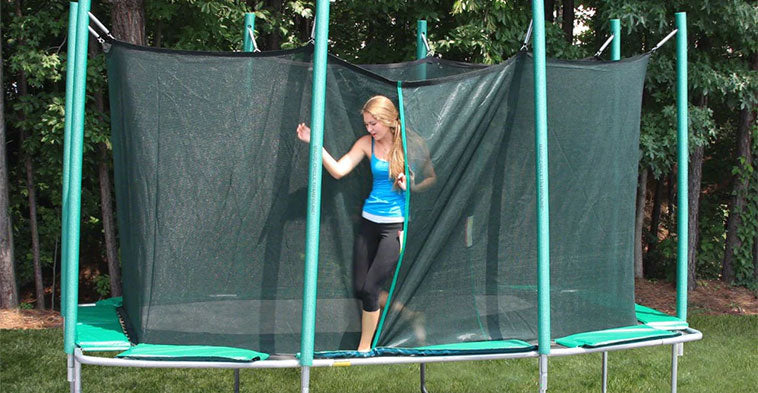
Lately, there has been a controversy over whether you should purchase an in-ground vs above- ground trampoline. Both types of trampolines have delighted children and adults alike. Trampolines are a lot of fun and provide great opportunities for exercise as well as other health benefits. Recently in-ground trampolines have grown in popularity. In-ground trampolines vs above ground can look more aesthetically pleasing in your landscaping. They have been considered safer than above-ground trampolines, for example, if a child is closer to the ground when they fall it can cause less damage. However, this is a misconception. Although in-ground trampolines are closer to the ground, a person can still fall from a high distance, perhaps six feet in the air. If a safety net is not employed, they can land on hard ground or even the retaining wall of the in-ground trampoline.
Another problem with in-ground trampolines is that for proper ventilation and drainage to occur it is often necessary to leave a gap between the end of the trampoline and the retaining wall. This increases the possibility for tripping when entering or exiting the trampoline. Moreover, small limbs can get trapped in these gaps when falling on the trampoline. But please don’t give up all hope of installing an in-ground trampoline.
An in-ground trampoline vs above ground can be more aesthetically pleasing. Whereas an above-ground trampoline is a highly visible and bulky piece of equipment. Both types of trampolines have excellent features. Which should you choose? In-ground vs above-ground trampolines? Let’s take a close look at both types of trampolines so you can decide which is better for you and your family. The answer really depends on your needs. Both types of trampolines have pros and cons. Let’s examine seven factors of both types of trampolines so you can make an informed choice:
In ground vs above ground trampolines. Which one should I buy?

Above-ground trampolines
Pros:
- Installation cost. Above-ground trampolines have low installation costs.
- They are not time consuming and are highly mobile. They are cheaper and easier to set up and can be used right away. You can position them wherever you want in the garden and move them around easily.
- Accessibility: It is easy to limit unsupervised access to young children. Above-ground trampolines are more easily accessed when they need repair.
- Above-ground trampolines have clear airflow, which gives a better bounce performance. They don’t have drainage or trapped moisture issues
- Storage. Above-ground trampolines can be stored away for winter. If you move house, you can easily pack up the trampoline and take it with you. Or if you or your children lose interest in the trampoline it can be stored away or resold.
Cons:
- They take up more vertical space and are not as aesthetically pleasing
- Weather resistance. Above-ground trampolines are more exposed to elements like rain which can cause rust and corrosion. They can blow away or be damaged in high winds. It may need to be taken down in winter and set up again in warmer weather. You may also need a large space to store it.
- They are not so easily accessible for use and may require a ladder. They are higher of the ground, causing more potential of injury if someone were to fall off it
In- ground trampolines
Pros:
- In-ground trampolines are more aesthetically pleasing and these built-in trampolines have numerous advantages to have. First and foremost they blend in with the surrounding landscape
- In ground trampolines vs above ground trampolines don’t require a ladder and are therefore more easily accessed, especially for children. They can be safer to use than above-ground trampolines as they are closer to the ground. They are safer for pets as there is no space for pets to crawl underneath while they are in use.
- Weather resistance. In ground trampolines vs above ground trampolines may require less maintenance for issues such as rust and corrosion. They are less likely to suffer storm damage. They don’t require winter storage.
Cons:

- Installation cost. In-ground trampolines have high installation costs. They are more expensive to install, requiring extensive landscaping to install pit, retaining wall, air vents and drainage.
- In ground trampolines vs above ground trampolines are static and not easily moved. They require a longer installation time. They are more time consuming to install because of the need for landscaping, levelling and digging.
- In ground trampolines have limited air-flow. This can cause parts to deteriorate faster and increases the risk of damp hampering bounce performance. Ventilation is an important factor to consider when installing an in-ground trampoline.
- An in-ground trampoline vs above ground trampoline is harder to access for repairs. Underground trampolines require more maintenance than overground trampolines. Because you can’t see what is happening under the trampoline you will need to have it serviced regularly. The frame, springs and jumping mat must all be checked regularly to ensure the best performance and that your family can use it safely.
- Weather resistance. In ground trampolines are more difficult to winterize. You will need to consider how the in-ground trampoline will be protected from the elements, such as rain and snow. And how these will drain from under the trampoline without causing stagnant water problems.
- You will still need to use a net for safe usage. A net should still be used with your in-ground trampoline to ensure children enter and exit the trampoline safely. A net also decreases the risks from falling and impacting on hard ground. It also prevents children from intentionally jumping out of the trampoline area, which increases the risk of injury. Both adults and children should always ensure a net is safely installed before using either above-ground or in-ground trampolines to minimise the risk of injury.
Additional factors to consider before installing an in-ground trampoline
Retaining wall

You may wish to build a retaining wall around your underground trampoline. A retaining wall can look aesthetically pleasing. You will need to have a strong barrier between the trampoline pit and the retaining wall so it doesn’t collapse into the pit in heavy rain. A retaining wall can help ensure dirt and debris does not enter the trampoline and pit. A concrete or stone wall is best.
Ensure room is left for drainage when designing the retaining wall. Standing water will cause rust and other deterioration of your trampoline. It can damage the foundations and cause your trampoline to become uneven. Perforated drainage pipes are ideal, preferably draining into an existing water system.
There will be times when the trampoline will need to be lifted, either for routine repairs or to retrieve an object that has dropped down the side. Be sure to leave adequate room for the trampoline to be lifted out of position, at least a one-foot gap all around. Also bear in mind that trampolines are heavy, some weighing hundreds of pounds.
Some nets need to be installed on the outside of the trampoline frame. You may need to leave room for this.
Ventilation
You can position the trampoline with the height on a level with the depth of the pit. The trampoline will be flush with the ground this way. But you may have problems with ventilation.
Ventilation affects the bounce quality. When a person jumps on a trampoline, the air is displaced and rushes out from underneath the trampoline. The air then rushes back in and this is what creates a high jump. If an in-ground trampoline is not properly ventilated it will decrease the bounce and increase pressure, possibly creating damage to the trampoline frame and to the person’s bones and joints.
Larger pipes running away from the trampoline can help with ventilation. You will need to have a good drainage system as pipes will need flushing occasionally. Covering the pipes with mesh will prevent some debris from clogging up the pipes.

You could instead leave a gap around the in-ground trampoline to allow for airflow. One downside of this is that, though this position is ideal for ventilation, it could create a risk of tripping. You could add fencing a few feet back from the trampoline to prevent the risk of tripping. Or invest in safety pads which can cover the gap while still allowing air to flow and adequate ventilation.
Or you can position the trampoline slightly above the pit. This ensures adequate ventilation and a better bounce. Again, there is a risk of tripping over the raised surface. A visible net enclosure would help to minimise this risk.
Other issues you may encounter
There are a few other issues you need to consider before installing an in-ground trampoline. Such as:
- Type of soil. Some types of soil are not conducive to installing an in-ground trampoline. Clay soil for example is slow to drain and can lead to a build-up of standing water which can rust and damage the trampoline. Regular or sandy soil is more suitable for installing an in-ground trampoline. If you must install an in-ground trampoline on clay soil, you should consider installing an electric pump to deal with standing water and curtail damage to the trampoline.
- Uneven ground. If uneven, the ground on which the in-ground trampoline is to be installed must be levelled before the trampoline can be installed.
- The ground underneath the in-ground trampoline must be treated prior to installation and treated annually to ensure weeds and grass don’t grow and overtake the trampoline.
Now you have had a clearer look at the factors involved in choosing an in-ground trampoline vs an above ground trampoline, I hope it will help in your future purchase. We carry a range of trampolines and safety nets to suit your needs.
For safety reasons, ensure you read all instructions thoroughly before installation and follow the manufacturer’s guidelines. The installation usually requires more than one person. We recommend that you employ a qualified landscaper or general contractor to carry out the installation.
Children should be supervised at all times when using a trampoline.

